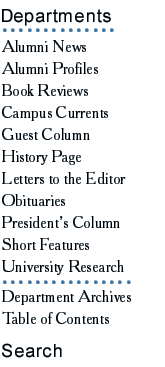

|

Search UNH Magazine: |
Megabyte Matchmakers "Political realities meant that we could not expect large amounts of state funding," says Reinhold, "yet the cost of educating students -- to have the proper resources and research materials -- was very expensive. I've been interested in solving that problem since that time."
By 1988, Reinhold had earned a master's degree in computer science at UNH. He was working at the university's Research Computing Center -- which provides computer services to UNH researchers on a contract basis -- and he was helping Prime Computing to find and correct bugs in its operating-system software. The Research Computing Center wasn't charging Prime for Reinhold's debugging work, and it began eating up too much of his time. "We told Prime Computing we couldn't spend this much time and energy," he says. "But Prime turned around and said, 'We'll pay you to do this stuff, because it has value to us.'" That gave Reinhold a vision of how to solve Dean Davis' problem and educate students using the latest high-tech equipment. "I realized we could generate resources by doing knowledge-intensive work that would cause the students to be trained in the areas we wanted," he says. The trick was to find tasks in areas that would be relevant to the students' training. "We wanted to do things related to computer communications, because that would bring in a lot of equipment and give students the knowledge base they needed." With that vision as its foundation, the InterOperability Lab developed by trial and experimentation. "I didn't want classroom settings, and I certainly didn't want to get involved in the formal academic setting, because there was too much baggage to go through that whole process," Reinhold observes. He came to realize that what he wanted was an apprenticeship model, where each student had a mentor. "That type of training has been used for ages on end. It's a very successful method." But the cost of such training is high, and Reinhold knew he couldn't count on university, state or federal funds. "This was all bootstrapped," he says proudly. "So we had to just sort of hack and whack our way through things, getting from one point to another." Early on, the lab tested data-communications technologies known as 10BaseT and FDDI (pronounced "fiddy," it stands for Fibre Distributed Data Interface). These were early technologies used to connect computers in the same room or building.
9 Edgewood Road Durham NH 03824 (603) 862-2040 alumni@unh.edu |